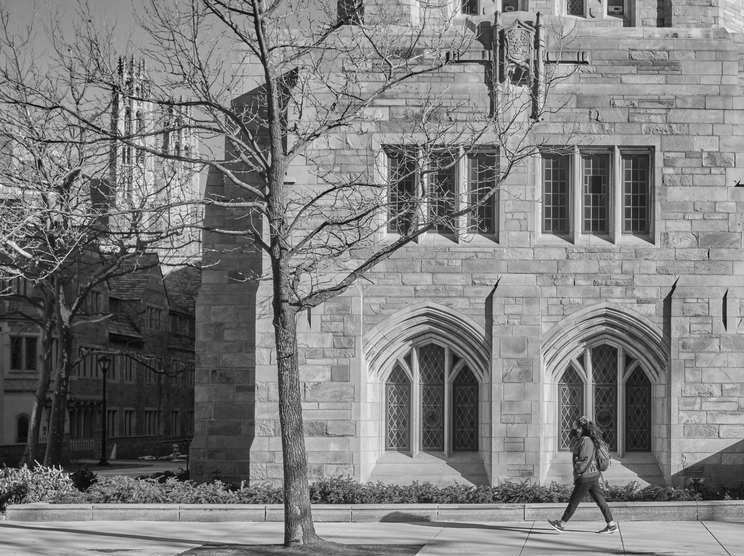
9 minute read
NEWS
SCITECH
ROBERT FROST AMERICAN POET
Advertisement
Yale researchers establish link between plant evolution and drought resistance
BY SELIN NALBANTOGLU STAFF REPORTER
Plants with more complex water transport structures are more resistant to drought conditions, making them more likely to survive and pass this characteristic on to their offspring.
That’s the conclusion Yale researchers have reached after poring over the fossil records of ancient plants that span tens of millions of years.
Earlier this month, a group of University affiliates working with faculty from Bates College, the University of Maine and Haverford College, among other institutions, published a paper on identifying the impact of droughts and drought resistance in determining plant structure over time.
“This study is an excellent example of how a collaborative, multidisciplinary approach can yield novel insights into evolutionary questions,” Jonathan Wilson, an associate professor of environmental studies at Haverford College and an author on the paper, wrote in an email to the News. “Bringing together modeling, physiology and paleontology and integrating their data and methods shed a great deal of light on this period in plant evolution.”
Lead author Martin Bouda GRD ’17, a researcher at the Institute of Botany at the Czech Academy of Sciences, studies the network properties of plant parts such as root systems and how these systems affect water intake of plants. In this paper, he was responsible for conceptualizing the water transport within the plants and building computational models to analyze these hydraulic processes. Craig Brodersen, a professor of plant physiological ecology at the Yale School of the Environment, was the principal investigator for the paper.
According to Brodersen, this new research stems from his team’s previous work on drought tolerance in plants such as grapevines. Previously, they have used new imaging techniques to study the vascular systems of various plants and the effects of different vascular organization on plant survival in droughts.
Brodersen explained that during extreme drought conditions, plants may accumulate air bubbles in their vascular systems.
“These bubbles block the flow of water from the roots to the leaves,” Brodersen wrote in an email to the News. “One air bubble among the many hundreds to thousands of vessels in a plant might not cause too much harm initially, but these bubbles can spread between vessels wherever there is a connection to an adjacent one. Understanding how the vessel network of a plant is connected can then tell us something about how air bubbles spread, which becomes a greater problem during prolonged drought.”
The researchers used this framework as a guiding question to study the evolution of vascular plants over millions of years, according to Brodersen.
When conducting this research, the team of scientists referenced a collection of images put together over the past century by various paleobotanists. The images depicted xylems, a specialized tissue responsible for transporting water and nutrients, of extinct plants. The fossil record, which spanned approximately 50 million years, gave the researchers an understanding of the arrangement of various vascular systems in plants.
“In this particular case, some of our previous work on the very fine structure of a vessel network got me thinking of the big picture instead: our living plants almost all have a gap in the middle of the network, whereas in the earliest land plants, the network occupied a solid cylinder of tissue,” Bouda wrote in an email to the News. “I built a little simulation to see if embolism spread differently on the two different cross-sections. The results were encouraging and fit in well with Craig’s ongoing work on seedless vascular plants.”
While Brodersen produced the actual microscope images of the networks within the plants the
TIM TAI/PHOTOGRAPHY EDITOR
Yale faculty has helped in publication of a paper detailing plant structure in determining outcomes during drought conditions.
researchers were studying, Bouda constructed idealized, possible networks to use as comparison cases for the observed networks.
Then, Bouda added, the researchers worked with Wilson to study fossil plants and realized that the fossil plants’ networks were more vulnerable to droughts than those of present-day plants.
“[T]here’s a clear pattern of xylem network shapes starting out with simple forms and becoming more complex,” Brodersen wrote. “Using the arrangement of the conduits within those vessel networks we were able to map out the possble pathways that air bubbles could spread from conduit to conduit. We then compared networks from extinct plants to living relatives today such as ferns and lycophytes.”
Using a computer model, the researchers were able to simulate drought conditions and study the effects of those conditions on various xylem configurations. The results suggested that the xylems of the earliest plants, which were also the simplest in arrangement, were the most vulnerable to air bubbles during a drought. Plants with a more complicated vascular system outperformed other species during the drought, according to Brodersen.
This paper is the result of interdisciplinary collaboration of experts in mathematical modeling, plant anatomy and paleobotany. The researchers applied current plant water transport theory and experimental work to their own inquiry. Brodersen explained that the team at Yale, including Bouda, developed the computer model and anatomical observations used to test their hypothesis. He added that Wilson served as the paleobotanist who helped “guide the species selection from the fossil record.”
Brodersen explained that this research stems from his laboratory’s collaboration with the plant breeding community. The findings could potentially inform the development of more drought-resistant varieties of plants.
According to Bouda, this paper helps elucidate “something fundamental about the structure and function of vascular plants that has been overlooked for a long time.” While the practical applications of the research are not immediately apparent, Bouda hopes that the findings might help diminish the tradeoff between crop yield and drought resistance, which has traditionally been a problem in agriculture.
“I thoroughly enjoyed exploring the paleobotanical fossil record,” Bouda wrote. “A lot of this was completely new to me, and I daresay both Craig and I got pretty excited discovering the variety of vascular forms that evolution had tried out over 400 million or so years. In the end, we found that we had taken a roundabout way to broadly reconstruct the dataset used by F. O. Bower a hundred years ago to show that vascular complexity depends on plant size, and that’s when the final piece of the puzzle snapped into place.”
Xylem comes from the Greek word xylon, meaning wood.
Contact SELIN NALBANTOGLU at selin.nalbantoglu@yale.edu.
Yale undergraduates develop award-winning strategy to prevent gun violence
BY ABEL GELETA CONTRIBUTING REPORTER
Three Yale undergraduates developed a multi-pronged approach to address the gun violence epidemic in the United States through various community resources and entity synergies, winning the Tulane Health Policy Case Competition and highlighting the potential for combining a youth mentorship program and firearm safety training to mitigate gun violence.
Abe Baker-Butler ’25, Patryk Dabek ’25 and Allie Dettelbach ’25 had the winning plan for reducing firearm homicides among the 41 teams from 22 universities that participated in the THPPC. After analyzing the status quo of gun violence in Opelousas, Louisiana, they created a plan — called Operation Healthy Homefront, or OHH — that integrated an after-school mentoring program and firearms safety instruction led by veterans in these communities.
“Gun violence is such a pressing issue, and it is so under-addressed,” Baker-Butler said. “There are so many common sense solutions attracting broadbased support. We’re happy knowing that we’ve been able to make at least some addition to the policy discussion around gun safety with our proposal, but we’re not done yet.”
The idea focuses on involving at-risk youth and veterans in the strategic development of a viable solution for communities with a high incidence of deaths or injuries from a firearm, while also serving as a mutually beneficial program aimed at providing essential skills and opportunities to youth and employment opportunities for veterans.
Baker-Butler described how his earlier experience with public health work tackling substance abuse in his high school and trying to provide accessible healthcare to low-income senior cit-

COURTESY OF SAM RIFKIND-BROWN
Yale students place first for their proposal for reducing gun violence in communities at the Tulane Health Policy Case Competition.
izens inspired him to compete in this event. All team members combined their interests in policy-making, public health and healthcare to produce a novel solution to a pervasive problem in the United States.
The strong collaboration between the three teammates in this competition allowed them to capitalize on each other’s skills and use the competition to gain new knowledge and create something of long-lasting impact.
Dettelbach noted how the team “wanted to think about how [they] could address that problem from a public health angle but also an angle of political feasibility.” This case competition allowed participants to analyze the multiple levels of government to devise solutions that would withstand the political obstacles to reducing gun violence in the United States.
He argued that numerous stakeholders must collaborate to commit enough resources and efforts toward reasonable, effective and sustainable attempts to mitigate the issues diverse populations face.
“We all learned about the policy-making bodies at each of those levels and the organizations that exist at those levels that we can harness to come to this final proposal,” said Dettelbach.
Dabek, along with Butler-Baker. initially brought up the idea to enter this competition with Dettelbach after hearing about it from Howard Foreman, Professor of Diagnostic Radiology, Economics, and Public Health. Dabek spent his summer delivering healthcare as an EMT and establishing a nonprofit to improve health conditions in war-ravaged Ukraine. In light of his summer experiences, he evaluated the public health issues plaguing the United States and accepted the opportunity to participate in this competition.
To comprehend how to advocate for social justice and health equity effectively, Dabek emphasized the importance of policy formation in implementing health equity in diverse communities.
Beyond policy proposal and implementation, all team members highlighted the need to collaborate closely with those communities they look to serve with this plan. Dabek said this proposal was only one step in developing the muchneeded solution to gun violence.
“We don’t forget about the people that we’re actually serving and the issues they’re dealing with, and we want to ensure we are in contact with the community and see what the community has to say,” said Dabek.
Baker-Butler recognized that the team is grateful to have won and received recognition from the judges. Still, he said, the solution to the gun violence epidemic requires numerous people to continue thinking and coming up with potential ideas to solve this problem.
Foreman encouraged his students in his Health Economics and Policy course to participate in this competition because the THPCC “was perfectly aligned with the mission of the class” which aims to “prepare students to critically think about actual challenges in society.” In many cases, Foreman stated, individuals might propose policy solutions and ideas that are “juvenile and naive” and make various suggestions and solutions that are not feasible in implementation.
Foreman highlighted the thoughtful and detailed nature of this team’s proposal.
“Every measure [for judging] that I’d look at … either passed or far exceeded my expectations,” said Foreman. “My expectation for a proposal of this type is to see something that agrees with the law; It’s not basically imagining a world where certain laws don’t exist … It’s not going to demand such enormous resources to be out of the scope of the problem.”
Foreman expressed his desire to witness this proposal be piloted on a small scale, improved and then scaled further to accommodate and assist vulnerable populations. In many ways, these are how programs are kick-started and implemented nationally.
Foreman believes that the students’ passion for this issue, coupled with the ability to gain enough attention and support, could be the catalyst for this proposal to be implemented effectively.
The presentation the winners presented to judges can be viewed at this link.






